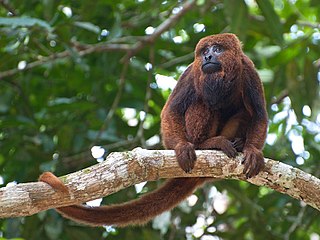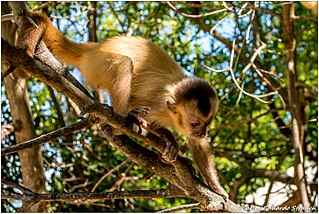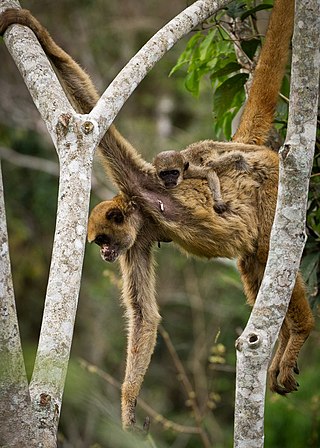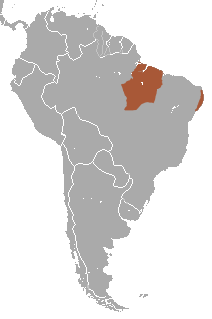
Howler monkeys are the most widespread primate genus in the Neotropics and are among the largest of the platyrrhines along with the muriquis (Brachyteles), the spider monkeys (Ateles) and woolly monkeys (Lagotrix). The monkeys are native to South and Central American forests. They are famous for their loud howls, which can be heard up to three miles away through dense rain forest. Fifteen species are recognized. Previously classified in the family Cebidae, they are now placed in the family Atelidae. They are primarily folivores but also significant frugivores, acting as seed dispersal agents through their digestive system and their locomotion. Threats include human predation, habitat destruction, illegal wildlife trade, and capture for pets or zoo animals.

The Atelidae are one of the five families of New World monkeys now recognised. It was formerly included in the family Cebidae. Atelids are generally larger monkeys; the family includes the howler, spider, woolly, and woolly spider monkeys. They are found throughout the forested regions of Central and South America, from Mexico to northern Argentina.

The Colombian red howler or Venezuelan red howler is a South American species of howler monkey, a type of New World monkey, found in the western Amazon Basin in Venezuela, Colombia, Ecuador, Peru and Brazil. The population in the Santa Cruz Department in Bolivia was split off as a separate species, the Bolivian red howler, in 1986, and more recently, splitting off the population in northeastern South America and Trinidad as the Guyanan red howler has occurred. All howler monkeys belong to the family Atelidae and the infraorder Platyrrhini.

The brown howler, also known as brown howler monkey, is a species of howler monkey, a type of New World monkey that lives in forests in southeastern Brazil and far northeastern Argentina (Misiones). It lives in groups of two to 11 individuals. Despite the name "brown howler", it is notably variable in colour, with some individuals appearing largely reddish-orange or black.

The black howler or black-and-gold howler, is among the largest New World monkeys and a member of the Alouatta genus. The black howler is distributed in areas of South America such as Paraguay, southern Brazil, eastern Bolivia, northern Argentina, and Uruguay. This species is sexually dimorphic, with adult males having entirely black fur and adult females and babies of both sexes having an overall golden colouring; which emphasizes black-and-gold in the name. The IUCN Red List has classed the black howler as Near Threatened as a result of a recent population reduction due to a variety of human-caused factors.

The Kaapori capuchin, also known as the Ka'apor capuchin, is a species of frugivorous, gracile capuchin endemic to the Brazilian Amazon. Their geographical home range is relatively small and is within the most densely populated region of the Amazon. With the strong human presence nearby,C. kaapori has had to deal with very large amounts of disturbances to their habitat and is one of the most endangered of the neotropical primates.

The black tamarin or western black-handed tamarin is a species of tamarin endemic to Brazil.

The white-eared titi monkey also known as the Bolivian titi or Bolivian gray titi, is a species of titi monkey, a type of New World monkey, from eastern Bolivia and an area of western Brazil. The species has a range that extends east from the Manique River in Beni Department, Bolivia to southern Rondônia in Brazil. The southern end of its range includes forests around the city of Santa Cruz de la Sierra.

The black bearded saki is a species of New World monkey, native to the Amazon rainforest of South America, specifically to an area of north-eastern Brazil. It is one of five species of bearded saki. Bearded sakis are medium-sized (50 cm), mostly frugivorous primates, specialised in seed predation. The genus name Chiropotes means "hand-drinker" as they have been observed using their hands as ladles for scooping water into their mouths. This behavior is thought to be a way of maintaining and protecting their characteristic beards. The black bearded saki's habitat has undergone heavy habitat fragmentation, making the future conservation status of the species uncertain.

The Peruvian spider monkey, also known as the black-faced black spider monkey, is a species of spider monkey that lives in Peru, as well as in Brazil and in Bolivia. At 60 centimetres long, they are relatively large among species of monkey, and their strong, prehensile tails can be up to 1 m (3 ft) long. Unlike many species of monkey, they have only a vestigial thumb, an adaptation which enables them to travel using brachiation. Peruvian spider monkeys live in groups of 20–30 individuals, but these groups are rarely all together simultaneously. The size and dynamics of the resulting subgroups vary with food availability and sociobehavioral activity. They prefer to eat fleshy fruit, but will change their diet in response to scarcity of ripe fruit. Individuals of this species also eat small animals, insects and leaves based on availability. Females separate from the band to give birth, typically in the fall. These females inhabit a group of core areas where resources are abundant in certain seasons. Typically, males exhibit ranging over longer distances than females, with movement of individuals enhancing the fluidity of subgroup size. Peruvian spider monkey are independent at about 10 months, with a lifespan of about 20 years.

The Amazon black howler is a species of howler monkey, a type of New World monkey, endemic to the south-central Amazon in Brazil. Until 2001, most authorities included it as a subspecies of the red-handed howler, though its distinction had already been pointed out much earlier. As suggested by its name, it typically appears entirely black.

The mantled howler is a species of howler monkey, a type of New World monkey, from Central and South America. It is one of the monkey species most often seen and heard in the wild in Central America. It takes its "mantled" name from the long guard hairs on its sides.

The Yucatán black howler, or Guatemalan black howler, is a species of howler monkey, a type of New World monkey, from Central America. It is found in Belize, Guatemala and Mexico, in and near the Yucatán Peninsula. It lives in evergreen, semideciduous and lowland rain forests. It is also known as the baboon in Belize, although it is not closely related to the baboons in Africa.
The Coiba Island howler is a type of howler monkey, a type of New World monkey, endemic to Panama. Although the Coiba Island howler has been recognized as a separate species by a number of authorities since a 1987 study of its fingerprints, mitochondrial DNA testing found it does not differ from mantled howler populations in any significant way. A reason given for treating it as a separate species is that the dermal ridges of its hands and feet differ from those of the mantled howler.

The northern muriqui is one of two species of muriqui. They are also known as woolly spider monkey because they exhibit the woollen pelt of woolly monkeys and the long prehensile tail of spider monkeys. Muriquis are the largest extant New World monkeys. They can reach 4.3 feet or 1.3 metres long and weight up to 7 to 10 kilograms. The northern muriqui is a critically endangered species, it is estimated that there are less than 1000 mature individuals in the wild. The species is unusual among primates in that they display egalitarian tendencies in their social relationships. This species is endemic to the Atlantic Forest region of Brazilian states of Rio de Janeiro, Espírito Santo, Minas Gerais and Bahia. Their diets, travel patterns and reproductive cycles are seasonally determined. The size of each group can fluctuate as females will move between groups of monkeys.

The Mexican howler is a subspecies of the mantled howler, A. palliata. This subspecies is found predominantly in forests between south eastern Mexico and north eastern Peru. Typical of its species, the Mexican howler monkey has a prehensile tail, a deep jaw, and a large pharynx which it uses to make characteristically deep and resonating howls. Mantled howler monkeys are known for forming unusually large cohorts averaging 14 members and sometimes extending to 40 members.
Alejandro Estrada is a primatologist and the author and editor of several books and articles about primates. He is a research scientist at the field research station Los Tuxtlas of Universidad Nacional Autonoma de Mexico He was the founder and executive editor of Tropical Conservation Science. Books he has authored or edited include New Perspectives in the Study of Mesoamerican Primates: Distribution, Ecology, Behavior, and Conservation, Frugivores and Seed Dispersal: Ecological and Evolutionary Aspects , Las Selvas Tropicales Humedas de Mexico: Recurso Poderoso pero Vulnerable and Comportamiento Animal: el Caso de los Primates.

Spix's red-handed howler is a species of Howler monkey native to the southeastern Amazon in Brazil. It is threatened by deforestation and hunting.
The Maderas Rainforest Conservancy is a nonprofit organization which was established to promote the conservation, protection, and management of Mesoamerican forests and animal and plant biodiversity through education, reforestation, preservation, and by working with local communities, and national and international institutions and universities.

Humboldt's white-fronted capuchin is a species of gracile capuchin monkey. It is found in Colombia, Venezuela, Brazil, and potentially the island of Trinidad.




















